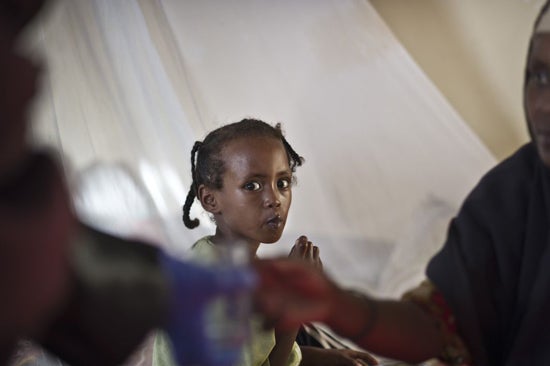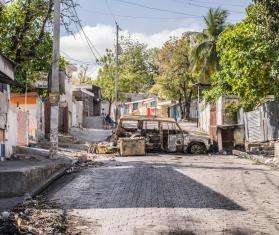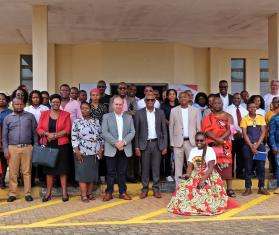Today in Somalia, measles is among the biggest threats to the survival of tens of thousands of vulnerable malnourished children.

Somalia 2011 © Sven Torfinn
This six-year-old girl from Galcayo, southern Somalia, became malnourished while she was ill with measles. She is receiving treatment at an MSF health facility.
Measles starts with a fever, a runny nose, and a cough. Then a rash usually appears. For children who are not immunized this often spells disaster. Today in Somalia, measles is among the biggest threats to the survival of tens of thousands of vulnerable malnourished children. The disease can sweep quickly through overcrowded displacement camps where malnutrition levels are high and immunity low.
A Vicious Circle
In Somalia, Doctors Without Borders/Médecins Sans Frontières (MSF) operates 13 medical and nutritional programs. Around 5,500 malnourished children are receiving therapeutic food while nearly 500 children suffering medical complications on top of severe malnutrition are being nursed back to health in eight intensive therapeutic feeding centers (ITFCs).
“Measles is an airborne infection and conditions in overcrowded camps create the perfect storm for outbreaks,” said MSF nutritionist Dr Susan Shepherd. “Malnourished children under five years old are the most susceptible. They get caught in a vicious circle where measles and malnutrition wear down their weakened bodies’ defenses, which can push them over the edge with complications like pneumonia and diarrhea. The first priority in such emergencies is to vaccinate against measles and to rapidly treat all the cases you can identify.”
High Measles Caseload
MSF projects in Somalia have detected a steady number of measles cases—3,049 since January this year. There was a marked rise in cases even before the onset of the nutrition crisis, but between May and September, a total of 2,132 cases were reported—70 percent of the year’s caseload in just four months.
In Hodan district, where MSF operates one of its three ITFCs in the capital, Mogadishu, more than 50 percent of the severely malnourished patients also have measles. These children are isolated from other children in the ward in order to prevent the spread of disease.
All MSF projects in Mogadishu have reported measles cases, whether in therapeutic feeding programs or through outpatient services. It is vital that patients who are identified as having measles symptoms by MSF outreach teams are quickly referred for treatment aimed at preventing complications, such as respiratory infections, from setting in. MSF teams in southern Somalia have also witnessed measles outbreaks in Marere and are working to treat and contain the spread of the disease there.
Somalia’s legacy of war, internecine conflict, lack of development, and a collapsed health system means that immunization coverage isextremely low; the World Health Organization puts it about 30 percent. This is a particular concern as MSF teams are finding and treating measles in older children and adults.
Stopping Measles – Difficult But Possible
MSF has already vaccinated more than 50,000 children against measles since July, mostly through outreach activities and small-scale immunizations, despite difficulties, constraints, and concerns for the safety of medical staff.
Implementing mass vaccinations, the first choice to fight outbreaks, is not easy in an insecure environment like Somalia. Several vaccination teams are needed and a typical team can consist of up to 10 people who need to be recruited, trained, equipped, and deployed. It also necessitates a lot of logistics support, including vital cold-chain management for the vaccine.
To do this in Somalia today is complicated. MSF has to undertake time-consuming negotiations with local leaders, authorities, and even armed groups who control particular areas of central and southern Somalia to allow vaccination campaigns that could save thousands of lives. But it doesn’t end there. Negotiations also often have to extend to simpler things like hiring people and vehicles, in one of the most difficult places in the world to bring medical humanitarian assistance.
MSF has worked continuously in Somalia since 1991 and currently provides free medical care in eight regions. More than 1,400 Somali staff, supported by approximately 100 staff in Nairobi, provide free primary healthcare, surgery, treatment for malnutrition, as well as support to displaced people through health care, water supply and relief items distributions in nine locations in southern and central Somalia. MSF is also providing medical care to Somali refugees in Kenya and Ethiopia.




